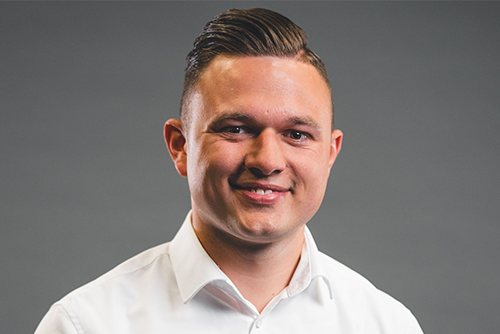Exterior lighting has taken on a new significance in modern vehicle construction. Decorative design elements are used as well as innovative signal lights. However, conventional measuring and test systems are not set up for lighting systems across the entire width of the vehicle. The EDAG lighting laboratory sets new standards here.
Not least due to changes in legislation in various markets, vehicle manufacturers now have greater scope for designing the exterior lighting of vehicles. And these are being used eagerly. On the one hand, for the design of light signals in road traffic, for example by means of interactive signaling displays (ISD), such as dynamic light displays that greet or bid farewell to the driver, or position lights at the rear that extend across the entire width of the vehicle.
Secondly, for the purpose of brand communication using decorative elements. Exterior ambient light or decorative lamps, which cover the entire surface of the radiator grille, for example, are intended both to appeal to the customer and to express the brand's self-image to other road users.
This creativity on the part of vehicle designers delights customers. However, such trends cause difficulties for developers. This is because measuring and test equipment, such as photogoniometers for validating designs or approval tests at the end of development, have not yet been designed for such large-area and exceptionally wide lighting systems (> 1 m).
Such lighting installations often have to be measured section by section in complex procedures and the results then reassembled. This not only costs time, but is also prone to errors, as measurement inaccuracies can occur during the test due to the multiple conversions. Manufacturers of lighting systems and vehicle manufacturers are therefore urgently looking for a remedy.

Photogoniometer with extreme coverage
EDAG has tackled this problem and set up its own light laboratory in which even very large illuminated components can be precisely measured. Examples include large radiator grilles or full-length rear lights.
The photogoniometer installed here is also one of the first in Europe that can measure the entire front or rear of a vehicle without any intermediate conversion. This is made possible by the use of a high-precision measuring robot. This can measure the components at different angles and positions to ensure a comprehensive light distribution analysis.
This considerably reduces the test effort and duration and leads to significantly better results. On the one hand, the measurement data is more precise and reliable. Secondly, more reliable statements can be made about the interaction of the individual lighting elements, for example the lighting of the radiator grille in combination with the headlights. Such practical analyses of the lighting properties in the overall context of the vehicle are particularly important for optimizing the lighting functions and ensuring road safety. 
Figure 1: The light measurement laboratory is an important addition to the services offered by EDAG's lighting competence center.
With the new lighting laboratory, EDAG is closing an important gap in its range of services. The engineering service provider now offers its customers a unique holistic service portfolio in the field of lighting technology, consisting of development and validation.
360° lighting validation
EDAG's new light measurement center offers unique measurements for full-size lighting systems throughout Europe. It covers all the requirements of vehicle and component manufacturers. In detail, the range of services includes
- Measurement of the intensity:
- Gonio-photometric measurements
- Validation of the legal requirements
- Measurement of the color location:
- Investigation of the dominant wavelength and the color location
- High-precision measurement
- Measurement of luminance:
- Distribution of brightness and color gradients of lamp and overall lighting scenarios
- Quantitative analysis of the various statistics
- Measurement of the light intensity:
- Pocket Lux for mobile measurements and quick determination of light intensity
- Measurement at vehicle level:
- Complete vehicle measurement for benchmarking or other purposes
- Close contact with external partners for:
- UV, VIS, IR transmission and reflection measurement
- BSDF measurements and integration into simulation tools
Visualization of the measurement results
The new Light Lab is located at EDAG's Wolfsburg site, where a Zero Prototype Lab has recently been set up. This supports vehicle and component manufacturers in prototype-free development. One of the central components of the Zero Prototype Lab is a Dynamic Simulator DiM500 from the manufacturer VI-grade in combination with a high-performance server environment. It can be used to simulate driving in different environments and under different weather conditions.
This also allows the measurement results from the EDAG Light Lab to be visualized, giving an impression of how the lighting affects the driver or other road users. Regardless of the weather outside, it is possible to simulate driving in rain, fog, snow and other environmental conditions that can influence lighting performance. These simulations ensure that the lighting functions reliably and effectively even under extreme conditions. In this context, the control unit application can also be adapted via the CANoe interface in the vehicle.
Adjustments and optimizations can also be simulated to see what effect they would have. This reduces the need for physical prototypes and the necessary night and test drives. As a result, the development process can be significantly accelerated and costs reduced. Fewer physical journeys also go hand in hand with a reduction in environmental impact, i.e. a lower CO2 footprint from the development phase.
Complete coverage of DV and PV
Both the new Light Lab and the Zero Prototype Lab can be ideally combined with the EDAG Group's "Validation" area of expertise. With the Light Lab, a final gap in the service portfolio has been closed. OEMs as well as Tier 1 and Tier 2 component suppliers now have access to all the necessary testing and inspection options required for design validation and product validation (DV / PV), such as environmental tests, electronic tests, EMC tests and associated optical tests.

Figure 2: An overview of the existing service portfolio at the various locations
Light benchmarking in the EDAG light lab: exterior and interior in comparison
How does your vehicle lighting perform in direct comparison with the competition? In the EDAG lighting laboratory, we offer comprehensive benchmarking measurements for all relevant lighting functions - both exterior and interior. Our offer is aimed at OEMs, suppliers and developers who want to analyze their systems objectively and compare them with the competition.
OEM-independent vehicle selection - maximum flexibility
The selection of comparison vehicles is crucial in the benchmarking process. At EDAG, customers have the choice: they can provide their own vehicles or rely on our support in organizing relevant comparison vehicles - regardless of the manufacturer. In this way, we enable a flexible and targeted competitive analysis.
Exteriorlight: Precise far-field measurements for main lighting functions
In the outdoor area, we evaluate the main lighting functions - low beam, high beam and Adaptive Frontlighting Systems (AFS) - under controlled laboratory conditions in the far field. The range, illumination characteristics and distribution are precisely measured, documented and comparatively analyzed.
Signal light functions: Homogeneity analysis with luminance camera
Signal light functions such as position lights, daytime running lights, indicators and brake lights are recorded with a high-resolution luminance camera. This allows us to evaluate the homogeneity of the light distribution, an essential factor for visibility, design quality and safety perception.
Interiorlight: focus on ambient lighting, HUDs and displays
In the interior, the focus is on functionality as well as the design effect. We measure:
- Ambient lighting along door panels, cockpit and center console
- Head-up displays (HUDs) in terms of brightness and image sharpness
- Instrument and infotainment displays in terms of contrast, uniformity and color fidelity
Luminance cameras are also used here to objectively assess homogeneity and light distribution.
Color location: measuring consistency and brand identity
Light color is more than just a design aspect - it conveys brand identity and influences perception. In the EDAG lighting laboratory, we precisely determine the color locations of all exterior and interior lighting functions. This allows us to evaluate the color consistency within a vehicle as well as in comparison to other brands.
Your competitive advantage through precise light benchmarking
EDAG and A2MAC1 formed a powerful partnership to combine our expertise and the dataset of the Benchmarking market leader. Together, we provide comprehensive light comparisons provide you with valid data for:
- Technological and economic positioning

- Target setting
- Design and quality assessment
- Optimization of own lighting systems
- Derivation of market trends and innovation potentials
EDAG is at your side as an independent partner - with experience, objectivity, and state-of-the-art measurement technology.
Are you also facing challenges in the validation of larger lighting systems? Then talk to Jannes Buthmann, Expert Lighting at EDAG Engineering. Or download our white paper "Innovative Simulation Center" right here, which describes the services of the Zero Prototype Lab and the Light Lab from EDAG. 





